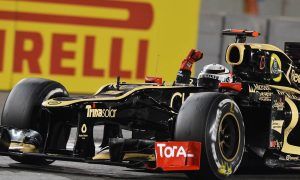
© XPB Images
What is your role when it comes to strategy?
“In theory, the strategy is quite simple: it’s the quickest way from lights out to the chequered flag! [Laughs] After Canada it was discussed at great lengths by the media that we should have swapped drivers. I can tell you from the information that we had available to us and the information that we had post-race it was definitely not the right thing to do. It wouldn’t have benefited the team and it wouldn’t have improved the overall team result. The way that decision came about was through a chain of people who used all the data that was available to us to make that decision. It wasn’t an emotional decision and it wasn’t because we favoured one driver, it was done because the data told us it wasn’t going to improve things and could possibly make things worse…
“After every single race we will analyse it, even if what we have seems like a good result, we will still analyse every decision to see if we could’ve done better. We also look at decisions that could’ve made it worse.”

© Force India
Are you also responsible for the pit stops?
“The team develops the pit stops back at the factory and at the circuit with a group of people. The senior strategy engineer and the operations manager put a lot of work into that, working with the guys and the data we get from pit stop performance and video.
“My role in the race is making sure the guys are in the pit lane when cars come in – which is a fairly straightforward role, but if you get it wrong, it can be a disaster! So many things can happen and a lot can change from the moment you decide to bring a driver in until he actually arrives in the pit box. It is something that we work on a lot and during the race it is my responsibility to call the pit crews attention and get them out into the pit lane when they need to be there with the correct instructions and information.
“I always say, when we look at the pit crew, we look at it like a rugby scrum. We’ve got all sorts of shapes and sizes involved, but if one of those guys doesn’t do his job correctly, you’re not going to win the scrum. So the key is to work as a team together, and if someone is struggling, one of their teammates is going to help them out.”

© XPB Images
What kind of relationship do you have with the drivers?
“My role is like everyone else in the team: to ensure they have everything they need to do the best possible job. I am here to answer any request they may have to make their job easier. On the flipside of that, I have to make sure they understand what is right and what is wrong especially when it comes to the sporting regulations, because as we all know drivers will see things differently to other people. So, it is very important for me to explain to them how to avoid trouble with the FIA. With the drivers we have at the moment, it doesn’t happen very often!”
Both Sergio and Esteban are fast and reliable, but what are their respective strengths?
“With Sergio it is well known that he is very good at managing his tyres in the race. The one thing that we have seen Sergio develop is his qualifying performance. Before he came to us, he was never really renowned for that. Over the last two years we have seen some incredible performances in qualifying. His pace has always been there and his tyre management has been good, but what has been most impressive are his qualifying performances, which have improved from race to race.
“Esteban is still new to Formula 1, but what impresses me with him, despite his limited experience, is how good he is. His qualifying is improving week on week, his race performances have been almost faultless. Obviously there was the issue in Baku, but his race craft has been extremely impressive, as has his ability to learn circuits. One of the most impressive things for me this year was him Esteban turning up in Melbourne and scoring a point on what is a pretty tough race circuit, that was a phenomenal achievement.”






